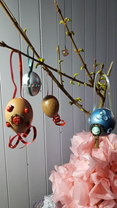Eggs, in many cultures and traditions, are a symbol of spring. I have always accepted this without giving much thought to the reasoning behind it. I assumed it was because eggs symbolise new life.
Today I had one of those moments, one where I thought how could I get to this age without knowing this!
Chickens have glands that affect growth and reproduction, and regulate their circadian rhythm (day and night). These glands can sense daylight through the chicken’s skull. Even a non-sighted chicken can sense the changing seasons. With less than 12 hours of sunlight, egg production will slow down, if not cease completely. In a natural society, before the advent of electric lighting, in winter eggs would have been scarce. With the balance of light and dark at the spring equinox, hens would start laying again. The humble egg was a definite sign that spring was finally here.
For many years now, I have brought a small branch (more like a large twig) into my home, usually one that has fallen in the March winds. We have decorated it with blown eggs, decorated in bright colours. It’s a great activity for children. And we have saved these eggs for future years – or at least till I dropped the box one year. As I found, egg shells are fragile. No problem, time to craft some more.
Cascarones are a tradition that evolved in Mexico, of hollow eggs filled with confetti. Eggs are hidden for others to find and once they are found they are crushed over people’s heads for good luck.
We love this tradition and have adapted it to help us celebrate the spring equinox. The blown eggs are filled with herbs and small trinkets like tiny pieces of crystal, spring flowers or even a miniature scroll, all carefully selected for the person the egg is intended for. These can be a keepsake, or cracked over their head. Warning – it can take a long time to remove dried herbs from your hair.

However you celebrate, I wish you the joy and hope of new beginnings.
Written by Portland Jones, PF Disabilities Liaison for the Midlands
